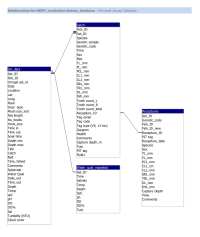Sea-floor depth below surface of the water body
Type of resources
Topics
Keywords
Contact for the resource
Provided by
Years
-
Bathymetry and Side Scan Sonar transects taken in various project locations within South Australian state waters. For analysis of seabed topography and interpretation of benthic substrate and flora.
-
Depth areas were derived by aggregating and dissolving the boundaries of the 1 degree S57 file series for the Australian continental shelf and Lord Howe Island shelf (200 m) depicting depth area polygons.
-
The intertidal area was derived by aggregating and dissolving the boundaries of the 1 degree S57 file series for the Australian continental shelf and Lord Howe Island shelf (200 m) depicting depth area features.
-
IMAS/CSIRO undertook a multibeam mapping campaign in eastern and Southern Tasmania to map shelf waters of the Freycinet, Huon and Tasman Fracture Marine Parks and several reference areas for the Tasman Fracture Park, including waters around Pedra Brancha and South-west Cape. The dataset includes a post-processed transit along the mid-shelf i=of Western Tasmania. The dataset includes raw mutibeam outputs and post-processed data, including Caris Files, xyz data and geotiffs. A data report for this has been produced by CSIRO. The study was intended to increase knowledge of the distribution of habitats within the SE Australian Australian Marine Park network, and at nearby reference areas with similar habitat. This information is required to underpin subsequent biological monitoring of key habitats within the AMP network, and to contrast the observations within parks with nearby fished locations to determine the extent that changes in biological communities are driven by natural vs anthropogenic pressures.
-
An environmental classification developed in conjunction with the NSW Marine Parks Authority Research Committee. For more information see: Breen D.A. and R.P. Avery. (2002). Broad-scale biodiversity assessment of the Manning Shelf marine bioregion. Draft final report for the NSW Marine Parks Authority. Copies of the report may be borrowed from the library: Environment Australia, GPO Box 787, Canberra ACT 2601 Australia. This coverage is intended for used in regional level marine conservation assessment. It was prepared using very low cost techniques (ie. unrectified API) and should not be relied upon for navigation purposes. ----------------------------------- This record describes the environmental classification of the four ocean ocean ecosystems classified by depth. The full study also describes classes for each of the five major estuary ecosystems, and nine habitat surrogates.
-
Water samples for the analysis of pigments using High Performance Liquid Chromatography (HPLC) were collected only in the first 12 months of the sampling program. Pigment analysis is used to estimate algal community composition and concentration. Pigments which relate specifically to an algal class are termed marker or diagnostic pigments. Some of these diagnostic pigments are found exclusively in one algal class (e.g. prasinoxanthin in prasinophytes), while others are the principal pigments of one class, but are also found in other classes (e.g. fucoxanthin in diatoms and some haptophytes; 19′-butanoyloxyfucoxanthin in chrysophytes and some haptophytes). The presence or absence of these diagnostic pigments can provide a simple guide to the composition of a phytoplankton community, including identifying classes of small flagellates that cannot be determined by light microscopy techniques. There was general similarity in pigment composition between all sites, with a presence of diatoms (as indicated by fucoxanthin), haptophytes (hex-fucoxanthin), prasinophytes (prasinoxanthan), cryptophytes (alloxanthan), cyanophytes (zeaxanthan) and green algae (chl-b) in nearly all monthly samples at all sites. The green algae could be in the form of euglenophytes or prasinophytes; the absence of the pigment lutein in all samples indicates that chlorophytes are not present in Storm Bay, at least at the sites sampled.
-
Chlorophyll a concentration is widely used as a proxy to describe trends in phytoplankton biomass over spatial and temporal scales. The concentration of chlorophyll a in Storm Bay showed surprisingly little variation across the seasons. There was a gradient in concentration from site 1 to site 3, where chlorophyll a decreased slightly. It was highest and most variable at the inshore sites 1 and 9, and lowest at site 3, furthest out in the bay. There was no clear annually recurrent seasonal bloom, although data suggests higher values in spring and autumn (see later time series).
-
Quantitative surveys were undertaken at four sites in the Kent Group, north eastern Tasmania (southern and northern shores of East Cove at Deal Island, Winter Cove at Deal Island, NE coast of Dover Island) by divers using underwater visual census methods to survey the reef habitat.
-
Belt transect surveys (50m) were used to monitor the benthic community structure through time at experimental (lobster additions/ research reserve sites or abalone diver urchin culls) and control sites in eastern Tasmania. Measures of percentage cover of key algal guilds, percentage of reef grazed by sea urchins, number of sea urchins (Centrostephanus rodgersii, Heliocidaris erythrogramma), Abalone (Haliotis Rubra), Rock lobsters (Jasus edwardsii) and type of substratum were recorded.
-

This database contains sampling effort, catch records, biological data, and water quality data for sampling and catches of elasmobranchs in northern Australian rivers, estuaries and coasts undertaken under the National Environmental Research Program (NERP) Marine Biodiversity Hub Project 2.4 'Supporting Management of Listed and Rare Species'. and the National Environmental Science Program (NESP) Marine Biodiversity Hub Project A1 'Northern Australian Hotspots for the Recovery of Threatened Euryhaline Elasmobranchs'. Surveys using gillnets and rod-and-line were undertaken in the Top End region of the Northern Territory and the Kimberley region of Western Australia. Selected animals were tagged for movement ecology, habitat use and mortality estimates (acoustic telemetry), and tissue samples were collected from all fish for molecular analyses (population genetics and close-kin mark-recapture).
 IMAS Metadata Catalogue
IMAS Metadata Catalogue